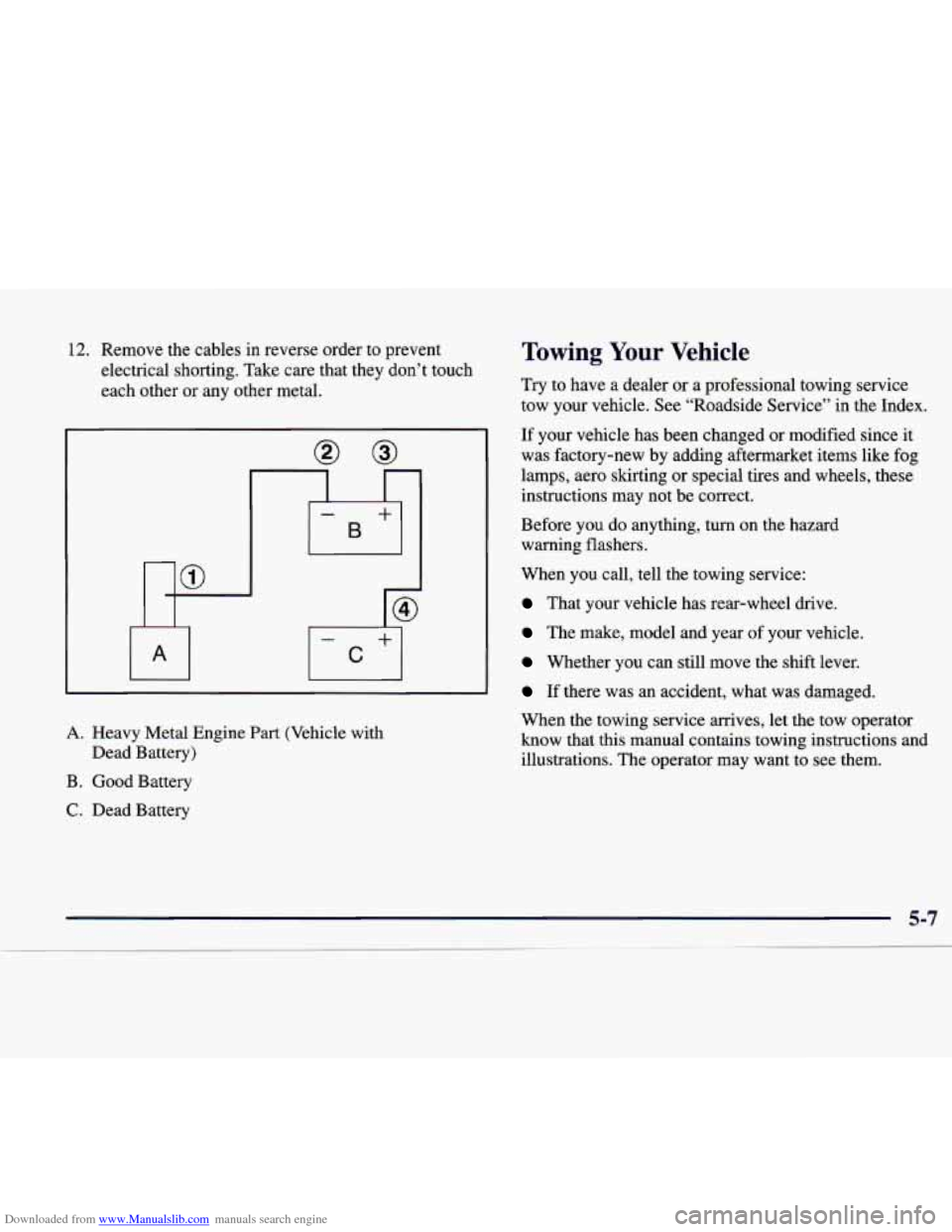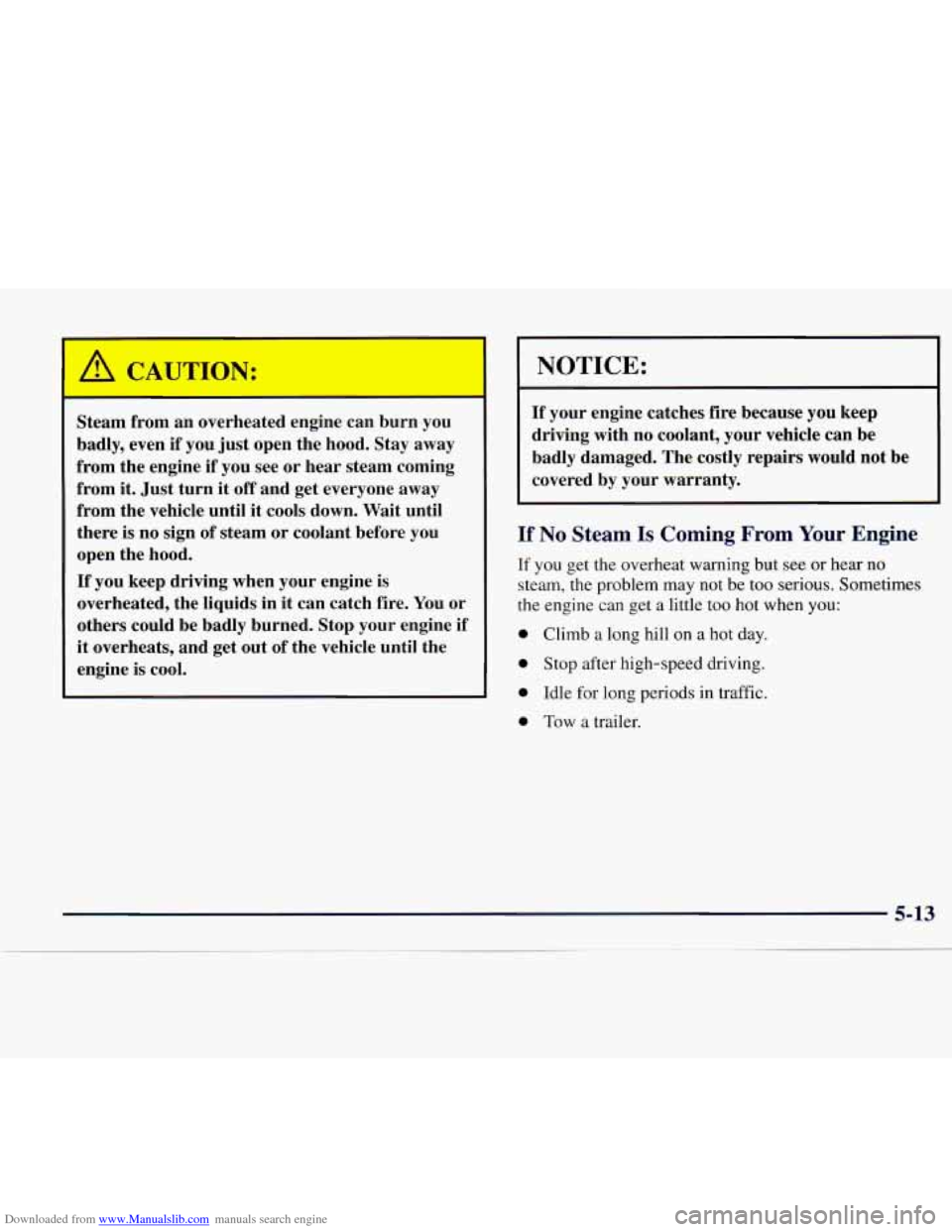Page 203 of 346
Downloaded from www.Manualslib.com manuals search engine Winter Driving
Here are some tips for winter driving:
0 Have your vehicle in good shape for winter.
You may want to put winter emergency supplies in
your
truok
Include an ice scraper, a small brush or broom, a supply
of windshield washer fluid, a rag, some winter outer
clothing, a small shovel,
a flashlight, a red cloth and a
couple of reflective warning triangles. And, if you will
be driving under severe conditions, include a small bag
of sand, a piece
of old carpet or a couple of burlap bags
to help provide traction. Be sure
you properly secure
these items in your vehicle.
4-24
Page 216 of 346
Downloaded from www.Manualslib.com manuals search engine ,*e* -*a
Section 5 Problems on the Road
Here you’ll find what to do about some problems that can occur on the road.
5-2 Hazard Warning Flashers
5-20 If a Tire Goes Flat 5-2 Other Warning Devices
5- 14 Cooling System
5-3 Jump Starting
5-3
1 If You’re Stuck: In Sand, Mud, 5-7 Towing Your Vehicle
5-21 Changing a Flat Tire
5- 12 Engine Overheating Ice or Snow
5-1
Page 217 of 346
Downloaded from www.Manualslib.com manuals search engine Hazard Warning Flashers
Your hazard warning flashers let you warn others. They
also let police know you have a problem. Your front and
rear turn signal lamps will flash
on and off.
Pressing this button on
the center console makes
the front and rear turn signal lamps flash
on and
off. The indicator light on
the button also flashes.
Pressing the button again
turns the flashers off.
The
flashers work regardless
of the key position.
When the hazard warning flashers are on, the turn signals
won’t work since they are already flashing.
Other Warning Devices
If you carry reflective triangles, you can set one up
at the side
of the road about 300 feet (100 m) behind
your vehicle.
5-2
Page 222 of 346

Downloaded from www.Manualslib.com manuals search engine 12. Remove the cables in reverse order to prevent
electrical shorting. Take care that they don’t touch
each other or any other metal.
A. Heavy Metal Engine Part (Vehicle with
Dead Battery)
B. Good Battery
C. Dead Battery
Towing Your Vehicle
Try to have a dealer or a professional towing service
tow your vehicle. See “Roadside Service” in the Index.
If your vehicle has been changed
or modified since it
was factory-new by adding aftermarket items like fog
lamps, aero skirting or special tires and wheels, these
instructions may not be correct.
Before you do anything, turn on the hazard
warning flashers.
When you call, tell the towing service:
That your vehicle has rear-wheel drive.
The make, model and year of your vehicle.
Whether you can still move the shift lever.
If there was an accident, what was damaged.
When the towing service arrives, let the tow operator
know that this manual contains towing instructions and
illustrations. The operator may want to see them.
Page 227 of 346
Downloaded from www.Manualslib.com manuals search engine Attach a separate safety chain around the bumper energy
absorbing shockhnit on the left side of the vehicle and
another safety chain on the right side tow hook.
Engine Overheating
You will find the warning light about a hot engine on the
instrument panel.
If Steam Is Coming From Your Engine
5-12
Page 228 of 346

Downloaded from www.Manualslib.com manuals search engine Steam from an overheated engine can burn you
badly, even if you just open the hood. Stay away
from the engine
if you see or hear steam coming
from it. Just turn it off and get everyone away
from the vehicle until it cools down. Wait until
there is no sign of steam or coolant before you
open the hood.
If you keep driving when your engine is
overheated, the liquids in it can catch fire. You or
others could be badly burned. Stop your engine if
it overheats, and get out of the vehicle until the
engine is cool.
NOTICE:
If your engine catches fire because you keep
driving with no coolant, your vehicle can be
badly damaged. The costly repairs would not be
covered by your warranty.
If No Steam Is Coming From Your Engine
If you get the overheat warning but see or hear no
steam, the problem may not be too serious. Sometimes
the engine can get a little too hot when you:
0 Climb a long hill on a hot day.
0 Stop after high-speed driving.
0 Idle for long periods in traffic.
0 Tow a trailer.
5-13
Page 229 of 346

Downloaded from www.Manualslib.com manuals search engine If you get the overheat warning with no sign of steam, try this for a minute or
so:
1. Turn off your air conditioner.
2. Dial temperature control to the highest heat setting
3. If you’re in a traffic jam, shift to NEUTRAL (N);
and open the windows, as necessary.
otherwise, shift
to the highest gear while
driving
-- DRIVE (D) or THIRD (3).
If you no longer have the overheat warning,
you can drive. Just to be safe, drive slower for about
10 minutes. If the warning doesn’t come back
on,
you can drive normally.
If the warning continues, pull over, stop, and park your
vehicle right away.
If there’s still no sign of steam, you can idle the engine
for two or three minutes while you’re parked, to see
if
the warning stops. But then, if you still have the
warning,
turn off the engine and get everyone out of the
vehicle until it cools down.
You may decide not to lift the hood but to get service
help right away.
Cooling System
When you decide it’s safe to lift the hood, here’s what
you’ll see:
A. Coolant Surge Tank with Pressure Cap
B. Electric Engine Cooling Fans
Page 232 of 346
Downloaded from www.Manualslib.com manuals search engine A CAUTION:
Adding only plain water to your cooling system
can be dangerous. Plain water, or some other
liquid like alcohol, can boil before the proper coolant mixture will. Your vehicle’s coolant
warning system is
set for the proper coolant
mixture, With plain water or the wrong mixture,
your engine could get too hot but you wouldn’t
get the overheat warning. Your engine could
catch fire and you
or others could be burned.
Use
a 50/50 mixture of clean water and
DEX-COOL@ coolant.
I NOTICE:
In cold weather, water can freeze and crack the
engine, radiator, heater core and other parts.
So
use the recommended coolant.
I A CAUTION:
You can be burned if you spill coolant on hot
engine parts. Coolant contains ethylene glycol
and
it will burn if the engine parts are hot
enough. Don’t spill coolant on
a hot engine.
5-17